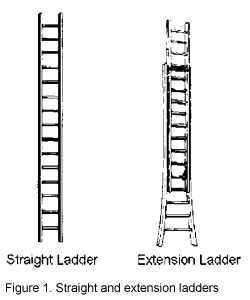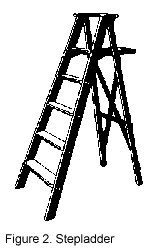No matter what type of ladder you use or what you use it for, it pays to take some extra precautions. Any fall can be serious, and a fall from the height of even a low ladder can mean a painful and incapacitating injury. The U.S. Consumer Product Safety Commission estimates that in one year 65,000 individuals receive emergency room treatment because of ladder accidents.
Taking proper precautions with ladders begins with choosing the ladder. Consider the type of work the ladder will be used for, the weight the ladder must carry, and the condition of the ladder.
Most ladders sold for household use are Type III light-duty ladders. These are rated for a maximum load of 200 pounds (user plus materials). If the ladder needs to carry more weight than this, select a Type II medium-duty ladder (225 pounds) or a Type I heavy-duty ladder (250 pounds). Most ladders will be labeled with their duty rating. Buy a ladder long enough for any use you may have for it. You should not stand on the top or top step of a stepladder, or the top three rungs of a straight or extension ladder. Keep in mind that the length of a ladder is different from its usable length. The height these ladders can safely reach is reduced by the angle at which the ladder must be set up.
When purchasing a new ladder, there are certain defects and features that are potentially dangerous. On metal ladders, check for sharp edges, dents and bent steps, rungs or rails. Wooden ladders should be free of splits, cracks, chips and all but small, tight knots. No ladder should have loose rungs or steps. Steps on wooden stepladders should be reinforced with metal rods or angle braces securely attached to the step and side rail. The bottom step of all stepladders should have metal angle braces. The stability of an individual stepladder can be checked by standing on the first step from the bottom and twisting the ladder. If it feels unsteady, choose another ladder. All metal ladders should have slip-resistant rubber or plastic feet. Metal stepladders should have slip-resistant steps. Some wooden stepladders also have this desirable feature. When using a ladder near power lines, use a wooden or fiberglass ladder since metal ladders conduct electricity.
Even a rigidly constructed ladder can be involved in an accident if proper precautions are not taken. Read and follow all instructions accompanying the ladder, set up the ladder properly, and use good sense while working on the ladder.
STRAIGHT AND EXTENSION LADDERS
 Taking proper precautions with ladders is an important step
in preventing these accidents. To raise a ladder, brace the
lower end against a wall and then grasp the top rung with
both hands. Raise the top end and walk underneath the ladder,
moving down the rungs until the ladder is vertical. Figure
1 gives an illustration of a straight ladder and an extension
ladder.
Taking proper precautions with ladders is an important step
in preventing these accidents. To raise a ladder, brace the
lower end against a wall and then grasp the top rung with
both hands. Raise the top end and walk underneath the ladder,
moving down the rungs until the ladder is vertical. Figure
1 gives an illustration of a straight ladder and an extension
ladder.
When using an extension ladder, raise it to the desired height, being sure the locks engage properly on both sides of the ladder. To position the ladder properly, place it against the wall so the distance between the wall and the base of the ladder is ¬ of the length along the ladder from the base to its point of support (¬ of its working length). Since the rungs on ladders are normally one foot apart, the approximate distance is easy to compute. If the ladder is to be used for getting onto a roof, there should be 3 feet of ladder (at least three rungs) extending beyond the edge of the roof. The ground under the ladder should be both level and firm. Large flat wooden boards placed under the ladder can level a ladder on uneven ground or give a ladder better footing on soft ground. If possible, secure the ladder. One way to do this is to have someone hold the bottom of the ladder.
Other points to remember when raising and positioning a ladder are:
Face the ladder when climbing or descending and use both hands. Mount the ladder from the center, not from the side. Tools should be carried in the pockets, in a bag attached to a belt, or raised and lowered by rope. Be sure that the soles of your shoes are clean and dry. Work facing the ladder, holding on with one hand. If it is ever necessary to work with both hands, hook one leg over the rung. Don't lean too far to the side while working. A good general guide is to keep your body centered between the rails of the ladder. Instead of leaning to the side, get down and move the ladder. In case of sudden dizziness or a panicky feeling, bow your head, drape both arms over the rung in front of you, close your eyes, and wait until the feeling passes.
Do not use a ladder as a scaffold or for any purpose except what was intended. Be very careful when using a metal ladder around electrical wires or equipment. Many fatalities occur when a metal ladder brushes against power lines while being moved. Use only double-insulated or properly grounded electrical tools on a metal ladder. To be safer, use only a dry wooden or non-conductive fiberglass ladder when working around electrical wires or equipment.
STEPLADDERS
 Many of the suggestions for using straight and extension ladders
also apply to stepladders. Figure 2 shows an illustration
of a stepladder. When using a stepladder:
Many of the suggestions for using straight and extension ladders
also apply to stepladders. Figure 2 shows an illustration
of a stepladder. When using a stepladder:
STORAGE AND MAINTENANCE
SOURCE
Acknowledgments
to Michelle L. Wallingford for her contributions to this
publication.
Publication #: AEX-691
This document is Ohio State University Extension, Columbus, Ohio 43210. Publication date: June 1992. Funded in whole or in part from Grant Number U05/CCU506070-02, "Cooperative Agreement Program for Agricultural Health Promotion Systems," National Institute for Occupational Safety and Health.
Reviewed by Drs. Dennis Stombaugh and Mike Veenhuizen, Department of Agricultural Engineering and Dr. Judy Wessel, Department of Family Resource Management, Ohio Cooperative Extension Service, Ohio State University, Columbus, Ohio 43210.
Disclaimer and Reproduction Information: Information in NASD does not represent NIOSH policy. Information included in NASD appears by permission of the author and/or copyright holder. More